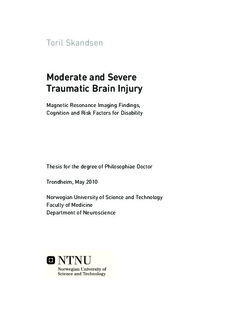| dc.contributor.author | Skandsen, Toril | nb_NO |
| dc.date.accessioned | 2014-12-19T14:21:23Z | |
| dc.date.available | 2014-12-19T14:21:23Z | |
| dc.date.created | 2010-10-07 | nb_NO |
| dc.date.issued | 2010 | nb_NO |
| dc.identifier | 355606 | nb_NO |
| dc.identifier.isbn | 978-82-471-2158-0 (printed ver.) | nb_NO |
| dc.identifier.isbn | 978-82-471-2160-3 (electronic ver.) | nb_NO |
| dc.identifier.uri | http://hdl.handle.net/11250/264052 | |
| dc.description.abstract | Traumatic brain injury (TBI) is a diagnosis comprising a heterogeneous group of patients. A TBI may be categorized as mild, moderate or severe depending on the level of consciousness after the trauma. It is generally accepted that individuals with moderate and severe TBI may experience long-lasting disability, but the frequency and magnitude of cognitive impairments or disabilities are not well described in neurosurgical cohorts that also include moderate injuries. Furthermore, there are few prospective, longitudinal follow-up studies describing early MRI findings.
The objective was to describe early MRI findings as well as the short-term and long-term consequences in samples of individuals with moderate and severe head injury. Furthermore, we sought to study risk factors for disability and epilepsy. We aimed at emphasizing a clinical approach, regarding methods as well as interpretation of results.
Two populations were studied, both including individuals with head injury that had been admitted to St. Olavs University Hospital. One population comprised all patients with severe head injury who had been treated at St. Olav Hospital from 1998-2002. The next population comprised all patients who have been treated with moderate and severe head injuries at St. Olavs Hospital from October 2004 to July 2009. From the latter population two samples were studied: first, a sample of 106 individuals (5-65 years) who had been examined with MRI within four weeks postinjury and second, a sample of 63 individuals (13-65 years) who had been tested with neuropsychological tests 3 months post injury. Control participants in the latter study were 48 healthy individuals, matched for gender, age and years of education.
In the MRI studies, we found that all but one of the patients had visible, traumatic lesions in the brain parenchyma. It was common to find a combination of contusions and diffuse axonal injury (DAI). DAI was very common, and was found in 90 % of patients with severe TBI and in 56 % of those with moderate injury. Patients with DAI had more severely disturbed consciousness as measured with the Glasgow Coma Scale (GCS) acutely after the accident. Only in patients with DAI, was the GCS score related to outcome. DAI was negatively related to outcome only when located in the brain stem.
Brain stem injury was found in 46 % of patients with severe head injury, but also 14 % of the patients with moderate TBI.
The individuals with TBI performed worse than healthy volunteers in most cognitive domains. We used the 5th percentile of the normative data as cut-off for impaired test score, and having _ 2 impaired test scores out of a selection of nine tests as definition of cognitive impairment. Doing so, we found that 43 % of the individuals with moderate TBI and 65 % of those with severe TBI had cognitive impairment. Cognitive impairment was associated with disability or complaints affecting daily life at 12 months post-injury. Yet, a substantial proportion of those with normal cognitive performance reported disability or complaints at the time of testing (69 %) or at 12 months follow-up (43 %). Thus, the sensitivity of the tests to a recent TBI or their ecological validity was rather low.
Two thirds of the individuals who survived a severe head injury, and virtually all with moderate head injury, experienced a favourable outcome, that is either no, minor or moderate disability, and independency of others in daily activities. In the first population of severe TBI, however, only one third could participate in paid work or ordinary education more than three years after the injury.
In both populations we found that approximately one third of those who survived severe TBI, experienced long lasting, severe disability, as measured with the extended Glasgow outcome scale. Severe disability was strongly predicted by bilateral brain stem injury on the MRI scan and being in a minimally conscious state or vegetative state 4 weeks post-injury, the latter also being a strong risk factor for epilepsy. | nb_NO |
| dc.language | eng | nb_NO |
| dc.publisher | NTNU | nb_NO |
| dc.relation.ispartofseries | Doktoravhandlinger ved NTNU, 1503-8181; 2010:98 | nb_NO |
| dc.relation.ispartofseries | Dissertations at the Faculty of Medicine, 0805-7680; 436 | nb_NO |
| dc.relation.haspart | Skandsen, Toril; Ivar Lund, Tom; Fredriksli, Oddrun; Vik, Anne. Global outcome, productivity and epilepsy 3--8 years after severe head injury. The impact of injury severity.. Clinical Rehabilitation. (ISSN 0269-2155). 22(7): 653-62, 2008. <a href='http://dx.doi.org/10.1177/0269215508089067'>10.1177/0269215508089067</a>. <a href='http://www.ncbi.nlm.nih.gov/pubmed/18586817'>18586817</a>. | nb_NO |
| dc.relation.haspart | Skandsen, Toril; Kvistad, Kjell Arne; Solheim, Ole; Lydersen, Stian; Strand, Ingrid Haavde; Vik, Anne. Prognostic Value of Magnetic Resonance Imaging in Moderate and Severe Head Injury. A Prospective Study of Early MRI Findings andOne Year Outcome. . | nb_NO |
| dc.relation.haspart | Skandsen, Toril; Finnanger, Torun G.; Andersson, Stein; Lydersen, Stian; Brunner, Jan F.; Vik, Anne. Cognitive Impairment Three Months After Moderate and Severe Traumatic Brain Injury. A prospective follow-up study. . | nb_NO |
| dc.title | Moderate and Severe Traumatic Brain Injury: Magnetic Resonance Imaging Findings, Cognition and Risk Factors for Disability | nb_NO |
| dc.type | Doctoral thesis | nb_NO |
| dc.contributor.department | Norges teknisk-naturvitenskapelige universitet, Det medisinske fakultet, Institutt for nevromedisin | nb_NO |
| dc.description.degree | PhD i klinisk medisin | nb_NO |

